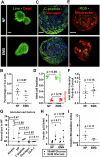A metabolic dysfunction-associated steatotic liver acinus biomimetic induces pancreatic islet dysfunction in a coupled microphysiology system
- PMID: 39397070
- PMCID: PMC11471816
- DOI: 10.1038/s42003-024-07006-7
A metabolic dysfunction-associated steatotic liver acinus biomimetic induces pancreatic islet dysfunction in a coupled microphysiology system
Abstract
Preclinical and clinical studies suggest that lipid-induced hepatic insulin resistance is a primary defect that predisposes to dysfunction in islets, implicating a perturbed liver-pancreas axis underlying the comorbidity of T2DM and MASLD. To investigate this hypothesis, we developed a human biomimetic microphysiological system (MPS) coupling our vascularized liver acinus MPS (vLAMPS) with pancreatic islet MPS (PANIS) enabling MASLD progression and islet dysfunction to be assessed. The modular design of this system (vLAMPS-PANIS) allows intra-organ and inter-organ dysregulation to be deconvoluted. When compared to normal fasting (NF) conditions, under early metabolic syndrome (EMS) conditions, the standalone vLAMPS exhibited characteristics of early stage MASLD, while no significant differences were observed in the standalone PANIS. In contrast, with EMS, the coupled vLAMPS-PANIS exhibited a perturbed islet-specific secretome and a significantly dysregulated glucose stimulated insulin secretion response implicating direct signaling from the dysregulated liver acinus to the islets. Correlations between several pairs of a vLAMPS-derived and a PANIS-derived factors were significantly altered under EMS, as compared to NF conditions, mechanistically connecting MASLD and T2DM associated hepatic-factors with islet-derived GLP-1 synthesis and regulation. Since vLAMPS-PANIS is compatible with patient-specific iPSCs, this platform represents an important step towards addressing patient heterogeneity, identifying disease mechanisms, and advancing precision medicine.
© 2024. The Author(s).
Conflict of interest statement
D.L.T., A.G., and M.E.S. have equity in Nortis, a company supplying MPS chips/some automation and EveAnalytics (accessing, analyzing, and computationally modeling data on patient-derived microphysiology systems).
Figures




Update of
-
A metabolic-dysfunction associated steatotic liver acinus biomimetic induces pancreatic islet dysfunction in a coupled microphysiology system.bioRxiv [Preprint]. 2024 Apr 30:2024.04.22.590598. doi: 10.1101/2024.04.22.590598. bioRxiv. 2024. Update in: Commun Biol. 2024 Oct 14;7(1):1317. doi: 10.1038/s42003-024-07006-7. PMID: 38712135 Free PMC article. Updated. Preprint.
References
-
- Control, C. f. D. & Prevention. National diabetes statistics report, 2017. Atlanta, GA: Centers for Disease Control and Prevention, US Dept of Health and Human Services (2017).
-
- Hartwig, S. et al. Secretome profiling of primary human skeletal muscle cells. Biochim Biophys. Acta1844, 1011–1017 (2014). - PubMed
Publication types
MeSH terms
Grants and funding
- 1706674/NSF | ENG/OAD | Division of Chemical, Bioengineering, Environmental, and Transport Systems (CBET)
- UH3 DK119973/DK/NIDDK NIH HHS/United States
- P30 DK120531/DK/NIDDK NIH HHS/United States
- UH3DK119973/U.S. Department of Health & Human Services | NIH | National Institute of Diabetes and Digestive and Kidney Diseases (National Institute of Diabetes & Digestive & Kidney Diseases)
- UH3 TR004124/TR/NCATS NIH HHS/United States
- R01 DK117881/DK/NIDDK NIH HHS/United States
- R01 DK135606/DK/NIDDK NIH HHS/United States
- UH3TR003289/U.S. Department of Health & Human Services | NIH | National Center for Advancing Translational Sciences (NCATS)
- 2229156/NSF | ENG/OAD | Division of Chemical, Bioengineering, Environmental, and Transport Systems (CBET)
- S10OD028450/U.S. Department of Health & Human Services | NIH | NIH Office of the Director (OD)
- R01DK117881/U.S. Department of Health & Human Services | NIH | National Institute of Diabetes and Digestive and Kidney Diseases (National Institute of Diabetes & Digestive & Kidney Diseases)
- R01DK135606/U.S. Department of Health & Human Services | NIH | National Institute of Diabetes and Digestive and Kidney Diseases (National Institute of Diabetes & Digestive & Kidney Diseases)
- S10 OD028450/OD/NIH HHS/United States
- UH3 TR003289/TR/NCATS NIH HHS/United States
- U24TR002632/U.S. Department of Health & Human Services | NIH | National Center for Advancing Translational Sciences (NCATS)
- U24 TR002632/TR/NCATS NIH HHS/United States
LinkOut - more resources
Full Text Sources
Miscellaneous

